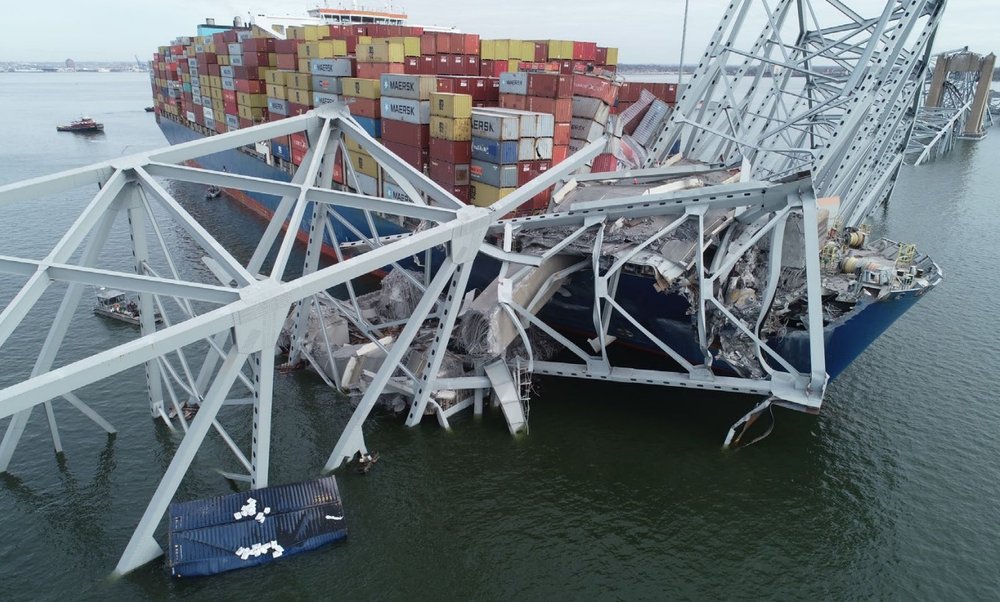NYC area bridges could be vulnerable to Baltimore-like ship strikes, feds say
March 21, 2025, 1:57 p.m.
Local transportation agencies say the risks are low due to the usual container vessel routes as well as natural and manmade protections.

Roughly a dozen bridges in New York and New Jersey haven’t undergone proper inspections for potential collapse from ship strikes, like the one that took down Baltimore's Francis Scott Key Bridge last year, according to a new report from the National Transportation Safety Board.
But local officials said the chances of such a catastrophe are unlikely because of natural and artificial protections as well as typical container ship routes.
NTSB investigators said the bridges, which include several major crossings in New York City such as the Verrazzano-Narrows, George Washington and Brooklyn bridges, are not in immediate danger. But the bridges’ design predates modern safety standards and ship traffic, so they have “an unknown level of risk of collapse from a vessel collision,” the investigators said.
"What we are telling bridge owners is that they need to know the risk and determine what actions they need to take to ensure safety," Jennifer Homendy, the board’s chair, said at a press conference Thursday.
Other structures the board cited include the Newark Bay, Manhattan, Williamsburg, Outerbridge Crossing, Newburgh-Beacon, Rip Van Winkle, Ogdensburg-Prescott International, Seaway International and Thousand Islands bridges.
The NTSB urged bridge owners to analyze the structures’ risk of failure from ship collisions, and, if necessary, take steps to reduce those risks.
The New York State Bridge Authority said by email it was reviewing the letter, and remains vigilant about the safety of its bridges.
The Key Bridge collapse on March 26, 2024, killed six construction workers after a cargo vessel lost power and rammed into a pier that supported the bridge. The bridge was built in 1977 and its risk level was almost 30 times greater than the acceptable threshold under modern standards, according to the NTSB report, which identifies 68 bridges across 19 states.
New York and New Jersey’s major bridge operators said their bridges either exceed those standards or are otherwise at low risk of ship collisions due to existing measures and geographical elements that provide protection. They pointed out that massive ships like the 984-foot-long Dali, which brought down the Key Bridge, would run aground in shallow water before hitting many of the local structures cited by the NTSB.

"Container ships like the Dali do not pass under the Outerbridge Crossing, Goethals or George Washington bridges,” said Steve Burns, a spokesperson for the New York and New Jersey Port Authority, in a statement on Friday. “The vessels that do pass underneath are one-third the tonnage and 400 feet shorter than the Dali.”
Burns added that all Port Authority bridges include fender systems as safeguards, and container ships are guided by multiple tugboats with trained pilots.
Catherine Sheridan, president of MTA Bridges and Tunnels, said in a statement that the agency’s vehicular bridges, including the Verrazzano-Narrows, "are routinely inspected, undergo regular maintenance and repairs, and have been evaluated based on the current [safety standards]” for vessel strikes.
The city Department of Transportation said it was reviewing the NTSB's recommendations and noted the East River, where its Brooklyn, Manhattan and Williamsburg bridges are located, is not big enough to accommodate megacontainer ships like the Dali.
The New Jersey Turnpike Authority, which oversees the Newark Bay Bridge, also said it was reviewing the federal report.
Still, the NTSB said formal risk assessments are necessary to determine appropriate countermeasures.
"Frankly, we've been sounding the alarm on this since the tragedy occurred," Homendy said. "We need action. Public safety depends on it."
Feds give NYC congestion pricing 30-day extension, slamming Gov. Hochul's 'open disrespect' NYC to lower speed limits to 20 mph in 4 outer-borough neighborhoods NYC’s crackdown on obscured license plates set to begin April 16